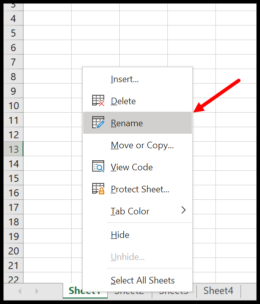Microsoft Excel, a powerful spreadsheet software, is widely used for data organization, analysis, and visualization. One fundamental skill every Excel user should master is the ability to rename sheets.
Renaming sheets not only enhances the organization of your workbook but also simplifies navigation, making it easier to locate and manage specific data sets. In this article, we’ll explore the reasons why renaming sheets is crucial, various methods to achieve it, and important considerations to keep in mind.
Why Rename a Sheet in Excel:
-
Clarity and Organization:
Renaming sheets brings clarity to your workbook, especially when dealing with complex datasets. A well-named sheet provides an immediate understanding of its content, making it easier for you and others to navigate through the workbook.
-
Improved Navigation:
Excel workbooks often contain multiple sheets, each representing a different aspect of data. Renaming sheets allows you to create a clear roadmap, helping users navigate effortlessly between various sections, saving time and reducing the likelihood of errors.
-
Enhanced Collaboration:
When collaborating on a project, clear and descriptive sheet names facilitate seamless communication among team members. It ensures everyone is on the same page and can easily locate the relevant information.
-
Professionalism:
Renaming sheets adds a professional touch to your work. It demonstrates attention to detail and a commitment to creating well-organized, user-friendly spreadsheets, which is crucial in a professional setting.

Methods to Rename a Sheet in Excel:
-
Double-Click Method:
The simplest way to rename a sheet is by double-clicking on the sheet tab. This activates the sheet name, allowing you to type in the desired name. Press ‘Enter’ to confirm the new name.
-
Right-Click Method:
Right-clicking on the sheet tab opens a context menu. From this menu, select “Rename.” This activates the sheet name, and you can enter the new name directly. Press ‘Enter’ to finalize the changes.
-
Keyboard Shortcut:
For those who prefer keyboard shortcuts, select the sheet tab and press ‘Alt’ + ‘H’ + ‘O’ + ‘R.’ This sequence activates the sheet name for editing. Type in the new name and press ‘Enter’ to complete the process.
-
Using the Format Menu:
Navigate to the “Home” tab on the ribbon, locate the “Format” option, and click on “Rename Sheet.” This opens a dialog box where you can input the new sheet name. Confirm by pressing ‘Enter.’
-
Using the Name Box:
The Name Box, located to the left of the formula bar, displays the current sheet name. Click on the Name Box, enter the new name, and press ‘Enter’ to apply the changes.
-
VBA (Visual Basic for Applications):
For advanced users, Excel’s programming language, VBA, provides a powerful tool for renaming sheets programmatically. This method is suitable for automating repetitive tasks or dealing with large datasets.

Things to Know About Renaming a Sheet in Excel:
-
Character Limit:
Excel imposes a limit on the number of characters allowed in a sheet name. Ensure your sheet name is concise and descriptive, staying within the character limit to avoid any issues.
-
Case Sensitivity:
Excel sheet names are case-insensitive, meaning “Sheet1” and “sheet1” are considered the same. However, for consistency and clarity, it’s advisable to choose a naming convention and stick to it.
-
Avoid Special Characters:
While Excel allows certain special characters in sheet names, it’s generally best to avoid them to prevent compatibility issues. Stick to letters, numbers, and underscores for optimal compatibility.
-
Updating Formulas and References:
If you have formulas or references pointing to a specific sheet, renaming that sheet may break those links. Be cautious and update formulas accordingly to ensure data integrity.
-
Worksheet Tab Color:
Excel allows you to color-code sheet tabs for better visualization. Right-click on the sheet tab, choose “Tab Color,” and select a color. This can be especially useful when dealing with a large number of sheets.
-
Protecting Sheets:
Renaming a sheet is possible even if the sheet is protected, but you must unprotect it first. Keep in mind the security implications and consider reapplying protection after renaming.
Bottom Line
In conclusion, mastering the art of renaming sheets in Excel is a fundamental skill that contributes to efficient data management and organization. Whether you opt for the straightforward double-click method or delve into VBA for more advanced tasks, understanding the various methods and considerations will empower you to create well-structured and professional workbooks.
Take the time to thoughtfully name your sheets, and you’ll find that it greatly enhances your overall Excel experience.
